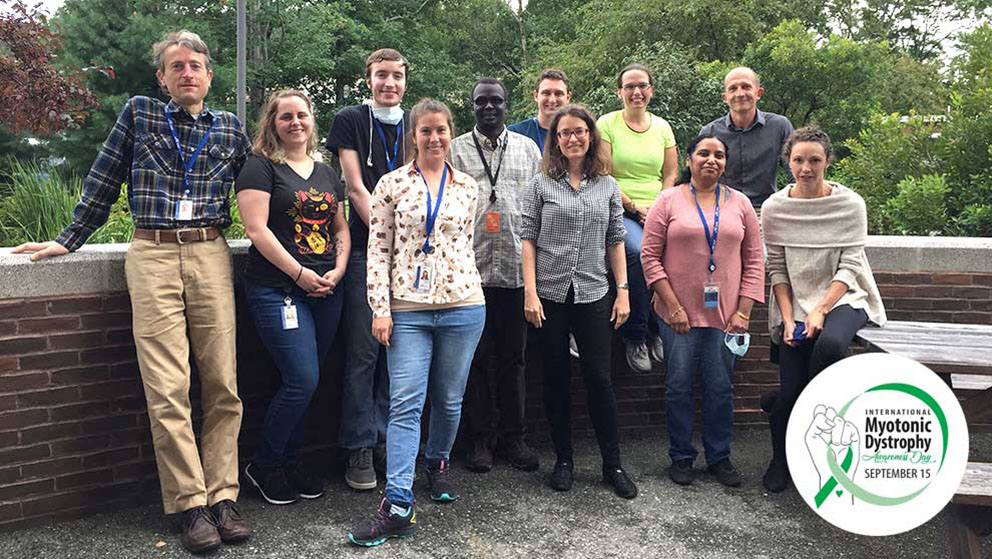 Laurent Bogdanik (rightmost end of upper row) and his team at The Jackson Laboratory for Mammalian Genetics in Bar Harbor, Maine.
Laurent Bogdanik (rightmost end of upper row) and his team at The Jackson Laboratory for Mammalian Genetics in Bar Harbor, Maine.
Myotonic Dystrophy Awareness Day takes place each year on September 15 and is hosted by the Global Alliance members of International Myotonic Dystrophy Awareness Day, of which JAX is a member. Raising awareness of myotonic dystrophy, a rare, multi-systemic inherited disorder, will help improve service provision, basic research, drug development, and policymaking related to the disease.
In honor of Myotonic Dystrophy Awareness Day, Laurent Bogdanik, Ph.D.Developing and optimizing mouse models for neurological disorders, researching the mechanisms of brain and muscle diseases, and supporting drug discovery with preclinical research services. Laurent Bogdanik , Ph.D., M.B.A. associate director of in vivo pharmacology at JAX addresses some questions about the disorder, below.
What is Myotonic Dystrophy?
Myotonic Dystrophy (DM) is a condition that prevents muscles from relaxing normally after contraction, making it difficult for patients to relax their grip for instance. DM also causes difficulties breathing and leads to muscle weakness. There are also changes in sleep/wake patterns resulting in daytime sleepiness, which makes it hard to engage in regular activities. DM has genetic origins. One of the mutations consists in the repetition of a very small DNA sequence, over and over, in the sequence of a gene called DMPK. This is the mutation that we work the most on, at JAX.
What advancements have been made in DM research over the last 5-10 years?
Like often is the case for research in genetic disorders, drug discovery has accelerated in the past 10 years thanks to mouse models with the same genetic mutations as the ones carried by patients. Almost 10 years ago, the first mouse model was created by Charles Thornton at The University of Rochester and since then, it has been used widely in the research community to understand DM better and develop therapies. New mouse models have been added to the collections available to researchers in the past few years which has allowed very promising proof of concept studies with new molecules that can enter the cells and block the deleterious effects of the DNA sequence repetition by attaching to it. Mice that used to develop the signs of DM had good remission under treatment. We just need to see now if these molecules can be manufactured in a way that they can be used as therapies in human.

Can you explain what research JAX is conducting?
Three years ago, JAX decided to play a more active role in helping biotechs and pharma develop a cure for DM. We worked with The Myotonic Dystrophy Foundation to establish colonies of mouse models for DM, so researchers can access them easily. We also created a “mouse testing center”, a team specialized on DM mice and able to measure their symptoms. Think about measuring muscle relaxation in a small mouse: this was not obvious, technically speaking, at first.
What impact does this have on the DM community?
This team documented a “natural history” of the development of symptoms in the Rochester mouse – exactly the same way natural histories are documented in patients, to help design clinical trials. The techniques and natural history we developed are now shared with drug developers, and our services help them administer therapeutic candidates and see how efficacious they are. In a way, you could say we worked to develop a “one-stop” for companies working on finding a cure, to make the testing easier and faster.
Why is it important for the community to get involved in awareness days like this?
The recent development of treatments for other genetic disorders categorized by muscular degeneration, like Spinal Muscular Atrophy or Duchenne Muscular Dystrophy, has shown that strong communities speed up the process of finding a cure. Awareness makes it easier for patients, families, foundations, philanthropists, companies and researchers to connect and team up toward a shared goal. Awareness days are also a way to show support for the families and patients: scientists, do most of their work “behind the scenes” and you rarely hear about them, but it is important for patients to know that there are hundreds of people working to find a cure.
What is one thing that you would tell someone diagnosed with DM that may be looking for hope?
In only the past few years, we have seen more progress in the understanding of genetic diseases like DM1 and the identification of therapeutic candidates, than in the decades before. Working with drug developers on a daily basis, we can also see that more and more of them are interested in finding a cure for DM1 - this all puts a treatment within reach - definitely.